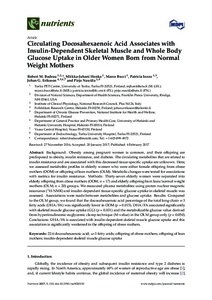Circulating Docosahexaenoic Acid Associates with Insulin-Dependent Skeletal Muscle and Whole Body Glucose Uptake in OlderWomen Born from Normal Weight Mothers
Pirjo Nuutila; Marco Bucci; Patricia Iozzo; Johan G. Eriksson; Robert M. Badeau; Miikka-Juhani Honka
Circulating Docosahexaenoic Acid Associates with Insulin-Dependent Skeletal Muscle and Whole Body Glucose Uptake in OlderWomen Born from Normal Weight Mothers
Pirjo Nuutila
Marco Bucci
Patricia Iozzo
Johan G. Eriksson
Robert M. Badeau
Miikka-Juhani Honka
MDPI AG
Julkaisun pysyvä osoite on:
https://urn.fi/URN:NBN:fi-fe2021042716795
https://urn.fi/URN:NBN:fi-fe2021042716795
Tiivistelmä
Background: Obesity among pregnant women is common, and their offspring are predisposed to obesity, insulin resistance, and diabetes. The circulating metabolites that are related to insulin resistance and are associated with this decreased tissue-specific uptake are unknown. Here, we assessed metabolite profiles in elderly women who were either female offspring from obese mothers (OOM) or offspring of lean mothers (OLM). Metabolic changes were tested for associations with metrics for insulin resistance. Methods: Thirty-seven elderly women were separated into elderly offspring from obese mothers (OOM; n = 17) and elderly offspring from lean/normal weight mothers (OLM; n = 20) groups. We measured plasma metabolites using proton nuclear magnetic resonance (1H-NMR) and insulin-dependent tissue-specific glucose uptake in skeletal muscle was assessed. Associations were made between metabolites and glucose uptake. Results: Compared to the OLM group, we found that the docosahexaenoic acid percentage of the total long-chain n-3 fatty acids (DHA/FA) was significantly lower in OOM (p = 0.015). DHA/FA associated significantly with skeletal muscle glucose uptake (GU) (p = 0.031) and the metabolizable glucose value derived from hyperinsulinemic-euglycemic clamp technique (M-value) in the OLM group only (p = 0.050). Conclusions: DHA/FA is associated with insulin-dependent skeletal muscle glucose uptake and this association is significantly weakened in the offspring of obese mothers.
Kokoelmat
- Rinnakkaistallenteet [19248]
